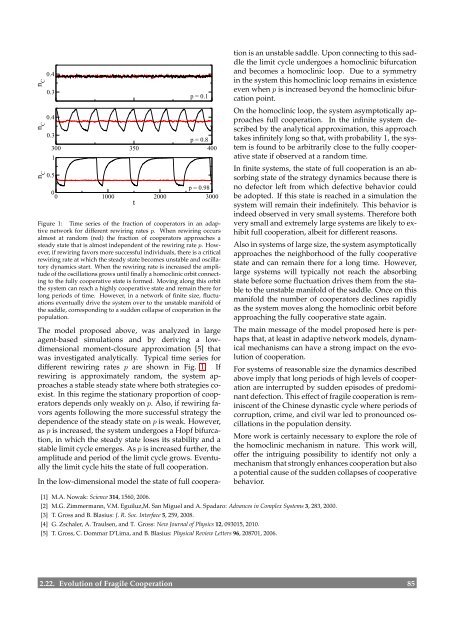Contents - Max-Planck-Institut für Physik komplexer Systeme
Contents - Max-Planck-Institut für Physik komplexer Systeme
Contents - Max-Planck-Institut für Physik komplexer Systeme
You also want an ePaper? Increase the reach of your titles
YUMPU automatically turns print PDFs into web optimized ePapers that Google loves.
agents following the respective strategy.<br />
n C<br />
n C<br />
n C<br />
0.4<br />
0.3<br />
0.4<br />
0.3<br />
p = 0.8<br />
300 350 400<br />
1<br />
0.5<br />
p = 0.1<br />
p = 0.98<br />
0<br />
0 1000 2000 3000<br />
t<br />
Figure 1: Time series of the fraction of cooperators in an adaptive<br />
network for different rewiring rates p. When rewiring occurs<br />
almost at random (red) the fraction of cooperators approaches a<br />
steady state that is almost independent of the rewiring rate p. However,<br />
if rewiring favors more successful individuals, there is a critical<br />
rewiring rate at which the steady state becomes unstable and oscillatory<br />
dynamics start. When the rewiring rate is increased the amplitude<br />
of the oscillations grows until finally a homoclinic orbit connecting<br />
to the fully cooperative state is formed. Moving along this orbit<br />
the system can reach a highly cooperative state and remain there for<br />
long periods of time. However, in a network of finite size, fluctuations<br />
eventually drive the system over to the unstable manifold of<br />
the saddle, corresponding to a sudden collapse of cooperation in the<br />
population.<br />
The model proposed above, was analyzed in large<br />
agent-based simulations and by deriving a lowdimensional<br />
moment-closure approximation [5] that<br />
was investigated analytically. Typical time series for<br />
different rewiring rates p are shown in Fig. 1. If<br />
rewiring is approximately random, the system approaches<br />
a stable steady state where both strategies coexist.<br />
In this regime the stationary proportion of cooperators<br />
depends only weakly on p. Also, if rewiring favors<br />
agents following the more successful strategy the<br />
dependence of the steady state on p is weak. However,<br />
as p is increased, the system undergoes a Hopf bifurcation,<br />
in which the steady state loses its stability and a<br />
stable limit cycle emerges. As p is increased further, the<br />
amplitude and period of the limit cycle grows. Eventually<br />
the limit cycle hits the state of full cooperation.<br />
In the low-dimensional model the state of full coopera-<br />
[1] M.A. Nowak: Science 314, 1560, 2006.<br />
tion is an unstable saddle. Upon connecting to this saddle<br />
the limit cycle undergoes a homoclinic bifurcation<br />
and becomes a homoclinic loop. Due to a symmetry<br />
in the system this homoclinic loop remains in existence<br />
even when p is increased beyond the homoclinic bifurcation<br />
point.<br />
On the homoclinic loop, the system asymptotically approaches<br />
full cooperation. In the infinite system described<br />
by the analytical approximation, this approach<br />
takes infinitely long so that, with probability 1, the system<br />
is found to be arbitrarily close to the fully cooperative<br />
state if observed at a random time.<br />
In finite systems, the state of full cooperation is an absorbing<br />
state of the strategy dynamics because there is<br />
no defector left from which defective behavior could<br />
be adopted. If this state is reached in a simulation the<br />
system will remain their indefinitely. This behavior is<br />
indeed observed in very small systems. Therefore both<br />
very small and extremely large systems are likely to exhibit<br />
full cooperation, albeit for different reasons.<br />
Also in systems of large size, the system asymptotically<br />
approaches the neighborhood of the fully cooperative<br />
state and can remain there for a long time. However,<br />
large systems will typically not reach the absorbing<br />
state before some fluctuation drives them from the stable<br />
to the unstable manifold of the saddle. Once on this<br />
manifold the number of cooperators declines rapidly<br />
as the system moves along the homoclinic orbit before<br />
approaching the fully cooperative state again.<br />
The main message of the model proposed here is perhaps<br />
that, at least in adaptive network models, dynamical<br />
mechanisms can have a strong impact on the evolution<br />
of cooperation.<br />
For systems of reasonable size the dynamics described<br />
above imply that long periods of high levels of cooperation<br />
are interrupted by sudden episodes of predominant<br />
defection. This effect of fragile cooperation is reminiscent<br />
of the Chinese dynastic cycle where periods of<br />
corruption, crime, and civil war led to pronounced oscillations<br />
in the population density.<br />
More work is certainly necessary to explore the role of<br />
the homoclinic mechanism in nature. This work will,<br />
offer the intriguing possibility to identify not only a<br />
mechanism that strongly enhances cooperation but also<br />
a potential cause of the sudden collapses of cooperative<br />
behavior.<br />
[2] M.G. Zimmermann, V.M. Eguiluz,M. San Miguel and A. Spadaro: Advances in Complex Systems 3, 283, 2000.<br />
[3] T. Gross and B. Blasius: J. R. Soc. Interface 5, 259, 2008.<br />
[4] G. Zschaler, A. Traulsen, and T. Gross: New Journal of Physics 12, 093015, 2010.<br />
[5] T. Gross, C. Dommar D’Lima, and B. Blasius: Physical Review Letters 96, 208701, 2006.<br />
2.22. Evolution of Fragile Cooperation 85
















